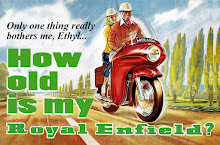 |
| Royal Enfield's new Classic 650 isn't a copy of the 1951 500 twin. |
Dubbing it "the most retro of them all," Ultimate Motorcycling's thorough description of the coming Royal Enfield Classic 650 twin neatly summarizes why it appeals.
Of all the Royal Enfield 650 twins -- Interceptor, Continental GT, Shotgun, Super Meteor and Bear -- the Classic 650 packs the clearest appeal to fans of historic British motorcycles.
It's upright, attractively styled, tastefully shiny, and powered by a parallel twin-cylinder motor.
It clearly references Royal Enfield twins of the past. EVO magazine reported that the "sweetly rounded tank plus a solo saddle" are a direct reference to Royal Enfield's first parallel twin motorcycle, the 500 twin of 1948.
"In fact, if you care to compare it to the new Classic 650 you can make out why and how (design chief) Mark Wells and his motley crew fell in love with the 500's lines to scale them up in more ways than one to present Royal Enfield's new flagship in all its grown-up build and grace," the magazine wrote.
Listen to Mark Wells enthuse about the Classic 650 in this brief Royal Enfield video.
Except, note that he doesn't mention the 500 twin in this video (he may have, elsewhere).
Comparing the 500 twin to the Classic 650 directly, it's easy to spot the differences in appearance. See the animation at the top of this blog item.
The separate gearbox, kick start lever, and neutral finder lever of the 500 twin impose a lot of busyness. Its straight up-and-down cylinders stand as erect as soldiers at attention. Its solo seat doesn't hide the springs that support it.
The Classic 650 caters more to modern tastes, with gearbox and motor encased together. Cylinders are canted forward and the side covers slant firmly forward.
The Classic 650 is tightly packaged. Its solo seat is tucked in, without springs. From some angles the big, unit powerplant seems to bulge with barely contained muscle.
One point of criticism has been the (overly?) generous rear fender, which at rest leaves a significant space over the rear wheel.
 |
| Does this rear fender make me look fat? |
It seems to awkwardly advertise the fact that the Classic 650's rear wheel is 18 inches, slightly smaller than its 19-inch front.
In contrast, the rear fender of the 1951 500 looks svelte, and closely follows the curve of the wheel. (Note that the front fender of the Classic 650 is relatively trim and tight.)
To be fair, some of the "classic" in the Classic 650 twin is supplied not by bodywork but by its vintage-looking color palate of Teal, Vallam Red, Bruntingthorpe Blue, and Black Chrome.
Why even bring up the comparison of a 2025 Royal Enfield to the 500 twin of (gasp) 75 years ago?
"For those not up to speed with post-war British motorcycle history, Enfield credits its 1948 500 Twin as one of the most important bikes in its long history, and indeed of its era," Dan Trent wrote in Goodwood Road and Racing.
Royal Enfield itself suggested the comparison; not the press. Its press release, reprinted on many websites says this:
"In the mid-20th century, streamlining was the optimistic promise of modernity, speed and progress. The streamline ‘speed-form’ was an integral part of the signature style of design masters such as Henry Dreyfuss and Raymond Loewy.
"On the 500 Twin, this influence was evident in the form of the teardrop-shaped fuel tank, side panels and, perhaps most prominently, the famous signature Royal Enfield casquette (nacelle) headlight housing.
"With the new Classic 650 Twin, the design team has taken this design language and evolved it, italicizing the stance of the motorcycle to give it a sense of motion even when stood still...
"The ‘500-Twin’ later evolved into further parallel twin models like the Super Meteor, Constellation, and Interceptor, but the 500-Twin is where it all started."
To that statement, Trent injects a note of realism regarding the new (yes, new!) Classic 650 twin.
"It may not look it, but this is a totally modern bike, riffing as it does on Royal Enfield tradition but based around that decidedly 21st-century engine and using up-to-date suspension and brakes to hopefully combine contemporary riding manners with a look harking back to the good old days. If, indeed, they were that good at all."
Those "good old days" were good, in part, because they looked forward, not back. The 500 twin of 1948 was Royal Enfield's step towards the future. In his book "Royal Enfield, The Postwar Years," Roy Bacon tells it this way:
"After the second world war there was a great rush among the British firms to get a twin cylinder model into their lists in opposition to the Triumph, which had come out first in 1937. Not for nothing was the (Triumph) Speed Twin advertised as the one with a 10-year start.
"In time all the major firms produced their twins as fast as postwar problems would allow them and Royal Enfield were no exception."
Royal Enfield's 500 twin had its own distinct history, triumphing in competition, improving in power and sophistication, and even getting better looking: the early models lacked the famous casquette, and had an enormous, ghastly, unsprung front fender.
The 1951 version was best looking, in my opinion, and so I've used it for the comparison animation.
During its run, the 500 twin would spawn "sport" and "deluxe" models, be saddled with the somewhat dowdy Airflow fairing, a toaster-shaped tank, and be renamed with the sad-sack moniker "Meteor Minor."
"A little sadly, this was not what sold motorcycles at that time for a decline had set in and was to last a decade, destroying much of the British industry in the period," Bacon writes.
"There was no longer any place for a 500 twin and so, in 1963, the final example of the small Enfield twin went from the range."
What remained were memories, and they are fond memories. The new Royal Enfield Classic 650 is, to me, the most interesting of the new 650s because it carries on into that future the 500 twin never got.
Basically, it's this: what if the motorcycle I wanted as a teen (but couldn't have) was suddenly available in 2025, updated and perfected? Would I want it? Wouldn't you?




























No comments:
Post a Comment